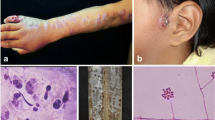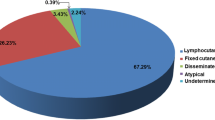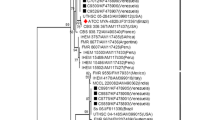Abstract
An autochthonous case of lymphocutaneous sporotrichosis caused by Sporothrix schenckii is reported. The patient developed skin lesions localized along the lymphatics that appeared after he suffered an injury while collecting wicker canes in marshy water. The fungus was identified as Sporothrix schenckii by MALDI-TOF and sequencing. Phylogenetic analysis was also performed. Low MIC values were detected for all tested echinocandins and azoles except for fluconazole. The patient was treated with itraconazole without significant improvement. A regression of lesions was observed after 3 months of therapy with voriconazole. Few cases of sporotrichosis have been reported in Europe. However, several cases of sporotrichosis have been described in Italy. The incidence of sporotrichosis in Italy may be underestimated and microbiologists, and clinicians must be aware of this fungal infection.



Similar content being viewed by others
Availability of data and material
The isolated strain of S. schenckii is available for authors having scientific interest.
References
de Beer ZW, Duong TA, Wingfield MJ (2016) The divorce of Sporothrix and Ophiostoma: solution to a problematic relationship. Stud Mycol 83:165–191. https://doi.org/10.1016/j.simyco.2016.07.001
Chakrabarti A, Bonifaz A, Gutierrez-Galhardo MC et al (2015) Global epidemiology of sporotrichosis. Med Mycol 53(1):3–14. https://doi.org/10.1093/mmy/myu062
Mora-Montes HM (2018) Special Issue “Sporothrix and Sporotrichosis”. J Fungi (Basel) 4(4):E116. https://doi.org/10.3390/jof4040116
Barros MB, de Almeida PR, Schubach AO (2011) Sporothrix schenckii and Sporotrichosis. Clin Microbiol Rev 24(4):633–654. https://doi.org/10.1128/CMR.00007-11
Marimon R, Cano J, Gené J et al (2007) Sporothrix brasiliensis, S. globosa, and S. mexicana, three new Sporothrix species of clinical interest. J Clin Microbiol 45:3198–3206. https://doi.org/10.1128/JCM.00808-07
Marimon R, Gené J, Cano J et al (2006) Molecular phylogeny of Sporothrix schenckii. J Clin Microbiol 44(9):3251–3256. https://doi.org/10.1128/JCM.00081-06
Queiroz-Telles F, Buccheri R, Benard G (2019) Sporotrichosis In Immunocompromised Hosts. J Fungi (Basel) 5(1):E8. https://doi.org/10.3390/jof5010008
Espinel-Ingroff A, Abreu DPB, Almeida-Paes R et al (2017) Multicenter, international study of MIC/MEC distributions for definition of epidemiological cutoff values for Sporothrix species identified by molecular methods. Antimicrob Agents Chemother 61(10):e01057–e01017. https://doi.org/10.1128/AAC.01057-17
Barile F, Mastrolonardo M, Loconsole F et al (1993) Cutaneous sporotrichosis in the period 1978-1992 in the province of Bari, Apulia, Southern Italy. Mycoses 36(5–6):181–185. https://doi.org/10.1111/j.1439-0507.1993.tb00747.x
Alberici F, Paties CT, Lombardi G et al (1989) Sporothrix schenckii var. luriei as the cause of sporotrichosis in Italy. Eur J Epidemiol 5(2):173–177. https://doi.org/10.1007/bf00156825
Criseo G, Malara G, Romeo O et al (2008) Lymphocutaneous sporotrichosis in an immunocompetent patient: a case report from extreme southern Italy. Mycopathologia 166:159–162. https://doi.org/10.1007/s11046-008-9121-4
Baroni A, Palla M, Iovene MR et al (2007) Sporotrichosis: success of itraconazole treatment. Skinmed 6(1):41–44. https://doi.org/10.1111/j.1540-9740.2007.05665.x
Ursini F, Russo E, Leporini C et al (2015) Lymphocutaneous sporotrichosis during treatment with anti-TNF-alpha monotherapy. Case Rep Rheumatol. https://doi.org/10.1155/2015/614504
Criseo G, Romeo O (2010) Ribosomal DNA sequencing and phylogenetic analysis of environmental Sporothrix schenckii strains: comparison with clinical isolates. Mycopathologia 169(5):351–358. https://doi.org/10.1007/s11046-010-9274-9
Author information
Authors and Affiliations
Corresponding author
Ethics declarations
Conflict of interest
The authors declare that they have no conflict of interest.
Ethics
The study did not require approval from the ethics committee, according to the Italian law, since it was performed in the context of normal clinical routines (Art. 1, Leg. Decree 211/2003). However, all patients referring to our institute provided consent for the use of their data for research purposes. In any case, data were previously anonymized, according to the requirements set by Italian Data Protection Code (Leg. Decree 196/2003).
Additional information
Publisher’s note
Springer Nature remains neutral with regard to jurisdictional claims in published maps and institutional affiliations.
Rights and permissions
About this article
Cite this article
Monno, R., Brindicci, G., Romeo, O. et al. Infection caused by Sporothrix schenckii: an autochthonous case in Bari, Southern Italy. Eur J Clin Microbiol Infect Dis 39, 2457–2460 (2020). https://doi.org/10.1007/s10096-020-03939-z
Received:
Accepted:
Published:
Issue Date:
DOI: https://doi.org/10.1007/s10096-020-03939-z




